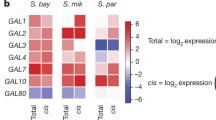Summary
The formation of ADHII in Saccharomyces cerevisiae is regulated by carbon catabolite repression. There are two genes involved in the formation of ADHII: ADR2, the structural gene as identified by electrophoretic variants and ADR1, possibly a regulatory gene. A new genetic element involved in the regulation of ADHII was identified by three allelic mutants insensitive to strong glucose repression. They were called ADR3 c (wild type designation ADR3) and found to be tightly linked to the structural gene, ADR2. The alcohol dehydrogenase found in ADR3 c mutants could not be distinguished electrophoretically from the ADHII of the glucose-sensitive wild type, ADR3.
Dominance relations between ADR3 c and ADR3 were established in diploids heterozygous for ADR3 and the two alleles of ADR2 (ADR2-S: slow ADHII, ADR2-F: fast ADHII). During growth on 10% glucose, an ADR3 c ADR2-F/ADR3 ADR2-S heterozygous diploid formed only the fast ADHII variant whereas an ADR3 c ADR2-S/ADR3 ADR2-F heterozygote produced only the slow form. This was taken as evidence of the cis-dominance of all ADR3 c alleles. The cis-effect of ADR3 c was also demonstrated in glucose-derepressed diploids. The ADR3 c mutations do not only cause glucose-insensitive ADHII formation, but also reduce the activity of the adjacent structural gene during derepression. Thus ADR3 c alleles were considered to be controlling site mutations. No pleiotropic effects were observed on the formation of enzymes related to the function of ADHII.
An adr1 ADR2 ADR3 single mutant did not form ADHII. In contrast to this, an adr1 ADR2 ADR3 c double mutant formed ADHII at a similar level as an ADR1 ADR2 ADR3 c mutant. This showed that ADR3 c was epistatic over adr1 (previously suggested as a positive regulatory gene). From this it was concluded that ADR1 is in fact a positive regulatory gene the function of which is required for the expression of the structural gene for ADHII, ADR2. ADR3 is the controlling site for the structural gene ADR2. Mutations at this site, ADR3 c, alleviate the requirement for the ADR2 gene product. ADR3 c is discussed as a promotor or operator site.
Similar content being viewed by others
References
Arst, H.N., MacDonald, D.W.: A gene cluster in Aspergillus nidulans with an internally located cis-acting regulatory region. Nature (Lond.) 254, 26–31 (1975)
Bergmeyer, H.U., Bernt, E.: D-Glucose. Bestimmung mit Glucose-Oxydase und Peroxydase. In: Methoden der enzymatischen Analyse, 2. Aufl., Bd. 2. S. 1172–1181 (ed. by Bergmeyer, H.U.). Weinheim/Bergstr.: Verlag Chemie 1970
Beck, C., v. Meyenburg, H.K.: Enzyme pattern and aerobic growth of Saccharomyces cerevisiae under various degrees of glucose limitation. J. Bact. 96, 479–486 (1968)
Beckwith, J., Rossow, P.: Analysis of genetic regulatory mechanism. Annu. Rev. Genet. 8, 1–14 (1974)
Berge, A.M.A. ten, Zoutewelle, G., Poll, K.W. van de, Bloemers, H.P.J.: Regulation of maltose fermentation in Saccharomyces carlsbergensis. II. Properties of a constitutive MAL6-mutant. Molec. gen. Genet. 125, 139–146 (1973)
Ciriacy, M.: Genetische Untersuchungen über multiple Formen der Alkohol Dehydrogenase von Saccharomyces cerevisiae. Diss. Univ. Freiburg i.Br. (1975a)
Ciriacy, M.: Genetics of alcohol dehydrogenase in Saccharomyes cerevisiae. I. Isolation and genetic analysis of adh mutants. Mutation Res. 29, 315–326 (1975b)
Ciriacy, M.: Genetics of alcohol dehydrogenase in Saccharomyces cerevisiae. II. Two loci controlling synthesis of the glucose repressible ADHII. Molec. gen. Genet. 138, 157–164 (1975c)
Dixon, G.H., Kornberg, H.L.: Assay methods for the key enzymes of the glyoxylate cycle. Biochem. J. 72, 3P (1959)
Douglas, H.C., Hawthorne, D.C.: Regulation of genes controlling synthesis of the galactose pathway enzymes in yeast. Genetics 54, 911–916 (1966)
Duntze, W., Neumann, D., Gancedo, J.M., Atzpodien, W., Holzer, H.: Studies on the regulation and localization of the glyoxylate cycle enzymes in Saccharomyces cerevisiae. Europ. J. Biochem. 10, 83–89 (1969)
Englesberg, E., Wilcox, G.: Regulation: Positive control. Annu. Rev. Genet. 8, 219–242 (1974)
Hynes, M.J.: A cis-dominant regulatory mutation affecting enzyme induction in the eukaryote Aspergillus nidulans. Nature (Lond.) 253, 210–212 (1975)
Jacobson, M.K., Bernofsky, C.: Mitochondrial acetaldehyde dehydrogenase from Saccharomyces cerevisiae. Biochim. biophys. Acta (Amst.) 350, 277–291 (1974)
Lowry, O.H., Rosebrough, H.J., Farr, A.L., Randall, R.J.: Protein measurement with the Folin phenol reagent. J. biol. Chem. 193, 265–275 (1951)
Lutstorf, U., Megnet, R.: Multiple forms of alcohol dehydrogenase in Saccharomyces cerevisiae. I. Physiological control of ADH-2 and properties of ADH-2 and ADH-4. Arch. Biochem. Biophys. 126, 933–944 (1968)
Magasanik, B.: Catabolite repression. Cold Spr. Harb. Symp. quant. Biol. 26, 249–262 (1961)
Perlman, P.S., Mahler, H.R.: Derepression of mitochondria and their enzymes in yeast: Regulatory aspects. Arch. Biochem. Biophys. 162, 248–271 (1974)
Polakis, E.S., Bartley, W.: Changes in the enzyme activities of Saccharomyces cerevisiae during aerobic growth on different carbon sources. Biochem. J. 97, 284–297 (1965)
Thuriaux, P., Ramos, F., Pierard, A., Grenson, M., Wiame, J.M.: Regulation of the carbamoylphosphate synthetase belonging to the arginine biosynthetic pathway of Saccaromyces cerevisiae. J. molec. Biol. 67, 277–287 (1972)
Toh-e, A., Oshima, Y.: Characterization of a dominant, constitutive mutation, PHOO, for the repressible acid phosphatase synthesis in Saccharomyces cerevisiae. J. Bact. 120, 608–617 (1974)
Wills, C., Phelps, J.: A technique for the isolation of yeast alcohol dehydrogenase mutants with altered substrate specificity. Arch. Biochem. Biophys. 167, 627–637 (1975)
Witt, I., Kronau, R., Holzer, H.: Repression von Alkoholdehydrogenase, Malatdehydrogenase, Isocitratlyase und Malatsynthase in Hefe durch Glucose. Biochim. biophys. Acta (Amst.) 118, 522–537 (1966)
Zimmerman, F.K., Eaton, N.R.: Genetics of induction and catabolite repression of maltase synthesis in Saccharomyces cerevisiae. Molec. gen. Genet. 134, 261–272 (1974)
Author information
Authors and Affiliations
Additional information
Communicated by H. Böhme
Rights and permissions
About this article
Cite this article
Ciriacy, M. Cis-dominant regulatory mutations affecting the formation of glucose-repressible alcohol dehydrogenase (ADHII) in Saccharomyces cerevisiae . Molec. gen. Genet. 145, 327–333 (1976). https://doi.org/10.1007/BF00325831
Received:
Issue Date:
DOI: https://doi.org/10.1007/BF00325831




